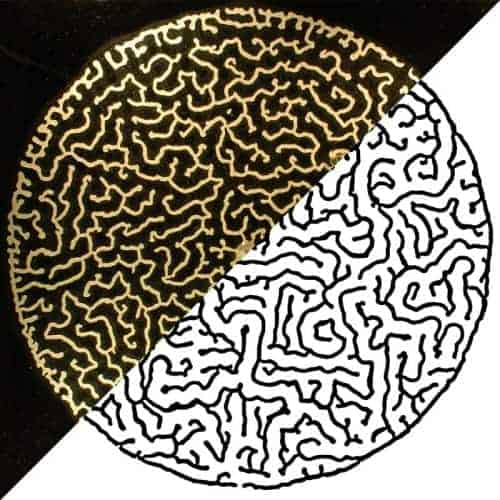Physicists in Norway have created beautiful maze-like patterns by simply allowing a mixture of tiny glass beads, water and glycerol to dry out slowly. Computer simulations suggest that the labyrinthine patterns are formed when "fingers" of air invade the solid-liquid mixture and push the beads apart. The researchers believe that the characteristic shapes of the patterns result from a balance between the forces of friction and surface tension in the mixture (Phys. Rev. Lett. 99 038001).

Labyrinthine patterns can emerge spontaneously in a number of physical systems including magnetic fluids and reaction-diffusion systems of chemicals. Physicists believe that such patterns arise because the systems are driven from equilibrium, where competing forces cause fingers of one phase of the system to invade another phase.
Bjornar Sandnes and colleagues at the University of Oslo created such patterns by combining glass beads (50-100 µm diameter) with water and glycerol and injecting the mixture into the narrow gap between two circular plates. The liquid was slowly pumped from a hole at the centre of the disk. After about three hours, the first fingers of air pushed into the edges of the disk and gradually moved towards the centre. After about three days, the entire disk was covered by a labyrinthine pattern made by dried beads that were pushed aside by the air (see Emerging labyrinth).
The team found that different patterns were produced when the concentration of beads in the initial mixture was changed. When the mixture contained fewer beads, the fingers of air were very large and the regions of dried beads were widely-spaced. When the mixture contained more beads, the air fingers were smaller and the regions of dried beads were spaced closer together.
The researchers then modelled the invasion in terms of two forces – the surface tension at the interface between air and fluid and the friction encountered by the finger as it pushes the beads aside in order to grow. These two forces were calculated at each time step in the simulation and the finger was then advanced in the direction of least resistance. By repeating these steps, the team were able to reproduce the patterns seen in their experiments (see Experiment and simulation).
According the researchers, the tips of narrow fingers encounter less friction than wider fingers because they push aside fewer beads as they grow. However, the tips of narrow fingers have a very high curvature, which means that their growth is more inhibited by surface tension than wider fingers. According to Sandes, the system strikes a balance between these competing forces, which defines the width of the fingers and the overall look of the labyrinths.
While the patterns resemble labyrinths observed other systems, Sandes told physicsworld.com that the simulation is specific to the forces acting on the bead mixture and therefore could not be used to study magnetic fluids or reaction-diffusion systems.




